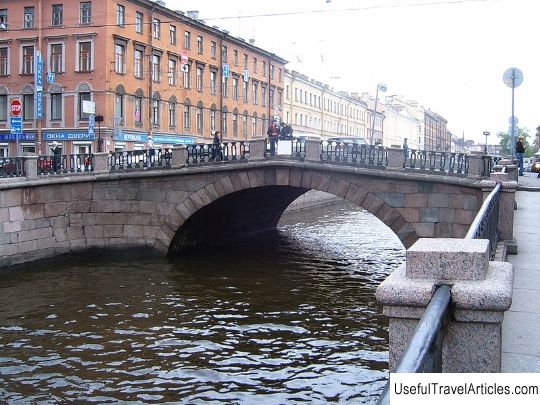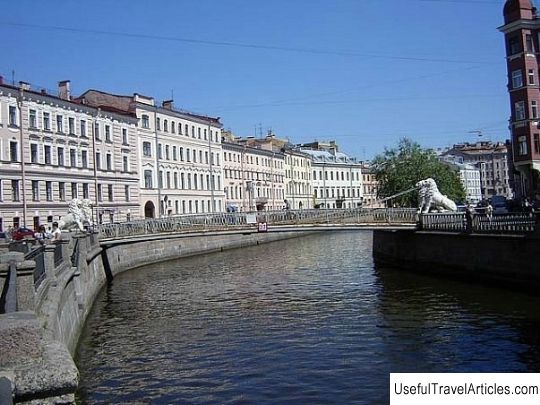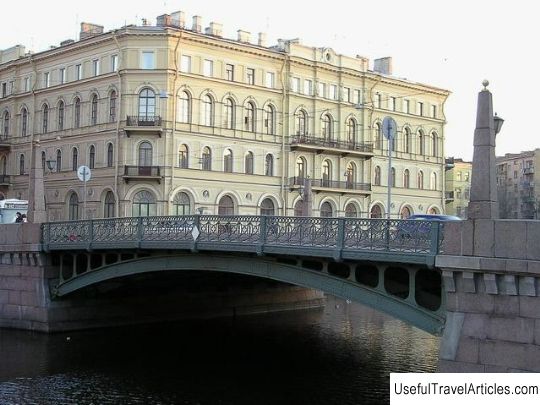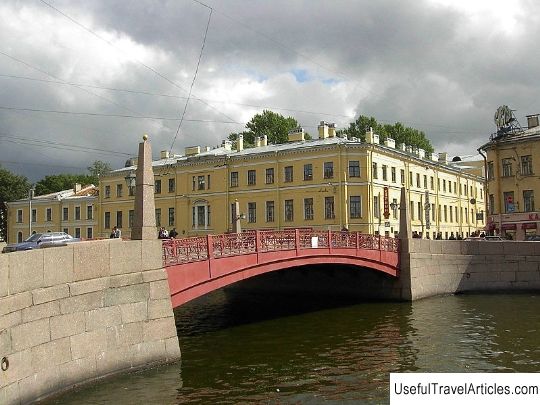Anichkov bridge description and photo - Russia - Saint Petersburg: Saint Petersburg
Rating: 7,5/10 (100 votes) 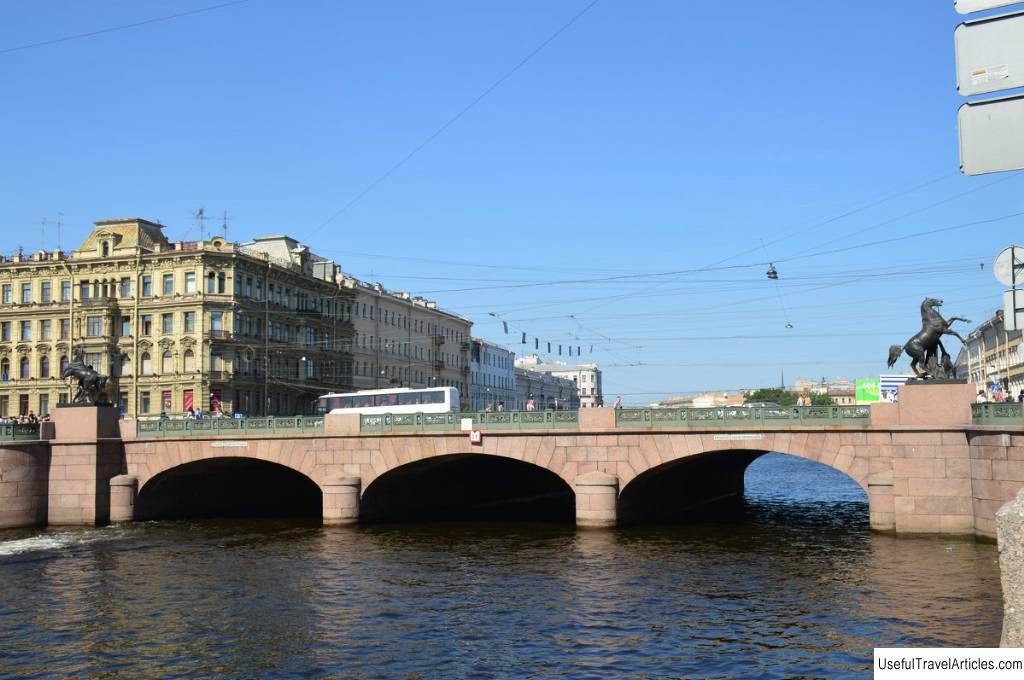
Anichkov bridge description and photos - Russia - Saint Petersburg: Saint Petersburg. Detailed information about the attraction. Description, photos and a map showing the nearest significant objects. Photo and descriptionOne of the most famous bridges of the northern Russian capital is Anichkov Bridge. It is located in the central part of the city, above the channel of the Neva delta. A bridge connects two islands . The bridge is about fifty-four and a half meters long and about thirty-eight meters wide. It is car and pedestrian. The bridge was opened at the beginning of the 18th century . It was originally wooden, but in the 80s of the named century it was rebuilt in stone. The name of the bridge comes from the surname of the lieutenant colonel of the times of Peter I ; the battalion under his command was stationed not far from the place where the bridge is now located. There is another version of the origin of the name of the bridge; according to her, it comes from the diminutive form of the name Anna. However, this version has not been confirmed by anything. The bridge in the 18th centuryAt the beginning of the 18th century, it became necessary to build Nevsky Prospect. An obstacle arose on the way of the builders - Nameless Erik (now known as the Fontanka River) . A decree of the emperor was issued, ordering to build a bridge across this river. The order of the monarch was executed very quickly. After a short time, the banks of the river were connected by a wooden bridge. The new bridge stood on stilts. It was girder and consisted of many spans. The bridge was quite long, since the width of the river was about two hundred meters. Drawings of this structure have not survived to our time, and there are no detailed descriptions left. However, historians know that, most likely, the bridge was painted "like a stone" (to make it look more solid). The bridge was being built by the same battalion, the name of the commander of which has survived to this day in the name of the bridge. In the 20s of the 18th century, the structure was rebuilt. Part of the bridge became liftable, since the river was deepened by that time, ships went along it. In the mid-20s and early 40s of the 18th century, serious repairs were carried out on the bridge. In the late 40s, it was replaced by a new bridge, also made of wood. It is currently unknown what exactly this structure looked like (there are different points of view). It should be noted that for a long time the bridge was located exactly where the territory of the city ended (the river was the border). There was a checkpoint next to it. В 80s of the XVIII century the bridge was rebuilt in stone . It was decorated with turrets. The spans of which it consisted were the same in size, they were blocked by stone arches. One of the spans was made of wood - the one that could open, allowing ships to pass (the bridge was drawbridge). The opening of this part of the bridge was carried out with the help of heavy chains stretched between granite turrets. The name of the author of the project of this structure is unknown to historians. The bridge in the 19th and 20th centuries In the 40s of the XIX century, there was an urgent need to build a new bridge. The avenue, the continuation of which was actually the old bridge, has expanded greatly. For this reason, a new, much wider bridge was needed. Another reason, according to which the construction of such a structure was necessary - the dilapidation of the wooden part of the old bridge. The construction project was developed by Ivan Buttats and Alexander Reder . Construction work was supervised by Andrey Gotman . The old bridge was dismantled, the new one was erected in a fairly short time: it took seven months to build. Now the towers on the bridge have disappeared, and the bridge itself has become a three-span one (as it is to this day); its pillars were faced with granite, and cast-iron railings were installed on it. The decoration of this railing was images of mythological creatures - horses with fish tails and mermaids. But the main decoration of the bridge was the statues mounted on granite pedestals. These sculptures can be seen today: they represent horse tamers. The statues were made by Peter Klodt . Also, pedestals for bronze vases were installed on the bridge. Later, it was decided to abandon these decorations, and the pedestals for them remained on the bridge: they can be seen there even today. Unfortunately, it quickly became clear that the construction of the bridge had significant flaws, due to which deformation process in the vaults . In the 19th century, several studies of the structure were carried out - at the beginning and in the second half of the 40s, in the 50s and 90s. And each of these studies confirmed a disappointing state of affairs: the bridge collapsed quickly enough. At the beginning of the 20th century, the situation became openly threatening. The reason for this was this: cracks formed between the granite cladding and the brickwork, where water entered. It was she who had a destructive effect (in conjunction with such factors as wind and frost). New bridge designs were prepared, but for various reasons none of them were approved. reconstruction of the old building has begun. It lasted for about three years. As a result, the bridge was restored and strengthened. More about sculptures Let's tell you more about the statues that adorn the famous bridge. The first two of them appeared on the bridge in the early 1840s. Bronze statues were installed on the west side of the bridge. On the opposite side, temporary, plaster sculptures were installed. They were exact copies of the first two statues and were painted with bronze paint. Later, they were replaced by bronze statues, but circumstances developed in such a way that the process of their replacement took a long time and consisted of several stages, often somewhat unexpected:
Each time, two bronze statues were removed from their pedestals on the bridge and replaced with plaster copies. But in the 50s of the XIX century, the sculptor, who needed to make the next two bronze copies of incredibly popular statues, decided to approach the task in a different way. He didn’t make copies (he was probably tired of making them by that time), but made completely new sculptures . They decorated the east side of the bridge. This time they stood firmly on their pedestals, no one tried to get them for their palace or park. Apparently, they fit so well into the overall composition of the bridge and the urban landscape that no one dared to break this harmony. The sculptures are still on the bridge today. However, in the 40s of the XX century, during the harsh wartime, the statues nevertheless left their pedestals. They were buried in the garden of one of the city's palaces: so they tried to protect them from enemy shelling. During the war, the statues were not damaged, after the end of hostilities they returned to their places. At the beginning of the XXI century, the sculptures left the bridge again - they were taken away for restoration . After a short time they were returned to the pedestals. Interesting fact On the bridge you can see a trace of a fragment of a fascist shell : this is a memory of the days of siege, of the 40s of the XX century. This trace was not restored. It is located on a granite pedestal of one of the statues in the northwestern part of the bridge. A memorial plaque is installed near it. It contains the following information: the number of shells fired by enemy artillery at Leningrad, and the years in which the city was subjected to systematic shelling. Note, that this is not the only trace of a German shell in the city that it was decided to keep. Similar traces with exactly the same memorial plaques can be seen on the facade of St. Isaac's Cathedral (or rather, on the columns and steps of the temple), as well as on the northern wall of the Savior on Spilled Blood. Although the bridge was badly damaged during the war, it was subjected to intense shelling many times, but nevertheless passed this test and continued to function. After the war, it did not even require major repairs, which indicates the high strength of its structure. In the second half of the 20th century, repairs were carried out several times, but they were relatively small; they are caused by the usual destruction that occurs over time.             We also recommend reading Porta e Torre de Almedina (Porta e Torre de Almedina) description and photos - Portugal: Coimbra Topic: Anichkov bridge description and photo - Russia - Saint Petersburg: Saint Petersburg. |
